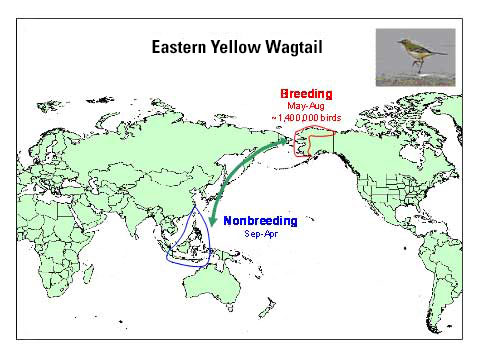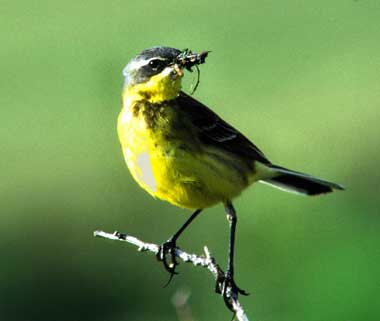Eastern Yellow Wagtail, Motacilla tschutschensis
High-Priority Species ListDuring the nesting season, which lasts from late May to mid-July, we will search for territorial wagtails and follow them back to their nests at both Cape Romanzof and Kawialik Lake. We will temporarily position 2-3 mist nets around each nest to capture both adult male and female wagtails visiting the nest to incubate eggs or feed young. During fall migration, which lasts from mid-July to mid-August, we will work solely out of Cape Romanzof and operate two mist-net arrays of 15 mist nets each at the mouths of Nilumat and South creeks. These are locations where staging wagtails have been previously captured during fall migration (McCaffery et al. 1998). Nets will be operated daily for 8-10 hours beginning at local sunrise. During nesting and migration, all captured wagtails and other target species will be aged, sexed, swabbed for actively shedding avian influenza virus, measured, banded, and released. A 50 µl of blood will be collected from the brachial vein of each bird upon request by the National Wildlife Health Center (NWHC). Additionally, all other non-target species of birds captured in mist nets incidentally to capture of wagtails will be similarly handled and sampled. Personnel will follow the protocols of the NWHC to protect themselves from Asian H5N1 and to collect, store, and ship samples. Cloacal swabs will be sent to the NWHC through Anchorage or Bethel for screening for Asian H5N1. Cloacal swabs from non-target species will be stored by the U.S. Fish and Wildlife Service in Anchorage and will be made available to the NWHC for screening upon request.
To obtain samples representative of wagtails from across the Asian wintering range of this species, sampling should also be conducted at additional sites in Alaska where the species reaches high breeding densities. Thus, work on Eastern Yellow Wagtails using the same methods as in the Askinuk Mountains will be conducted off of the road system on the Seward Peninsula in 2006. Additional surveillance among Eastern Yellow Wagtails will be considered for 2007 at Cape Pierce, Togiak National Wildlife Refuge; Kotzebue Sound; and the northern foothills of the Brooks Range along the Colville River. For the latter of these sites, EasternYellow Wagtail, Bluethroat, and Northern Wheatear may be captured incidental to sampling of Arctic Warbler in 2006 (see Arctic Warbler protocol).
No. of samples: 100 adult and 100 juvenile Eastern Yellow Wagtails
Sampling locations: Askinuk Mountains, Alaska. Cape Romanzof (1st preference) and Kawialik Lake (2nd preference).
Sampling timeframe: 21 May-15 August
Sample demographics: Adults and juveniles, males and females.
Methods of capture: Live capture, release.
Other targeted species: Bluethroat; Northern Wheatear; Wilson’s Warbler; Savannah and Golden-crowned sparrows; Common and Hoary redpolls.
Contact: Steven M. Matsuoka
Yukon Delta NWR
U.S Geological Survey
Contact: Colleen M. Handel
U.S. Air Force.
MCCAFFERY, B.J., C.M. HARWOOD, AND H. MOORE. 1998. Results of the 1997 avifaunal inventory, Cape Romanzof Long Range Radar Site, Alaska. Final report for Department of Defense Legacy project 97611CES001. Prepared for U.S. Air Force, 611th Air Support Group, Civil Engineer Squadron/Enironmental Flight, Elemendorf Air Force Base, Alaska. U.S. Fish and Wildlife Service Report, Bethel, Alaska.
MOORE, H. 2000. Nesting biology and population ecology of Yellow Wagtails breeding at Cape Romanzof, Alaska. Thesis. Cornell University, New York.

Ranking Score: 17.5
Asian H5N1 ranking criteria for Eastern Yellow Wagtail, Motacilla tschutschensis.
Total of partial contact with Asia1 |
Contact with known "hot spot"2 |
Habitat used in Asia3 |
Pop. in Alaska4 |
Can samples be obtained? |
Score |
5.0 |
2.0 |
3.5 |
4.0 |
3.0 |
17.5 |
Winters in Taiwan, Indonesia, Sunda Isles, and Moluccas |
s.e. Asia and Indonesia |
Terrestrial. Open areas with water, sugarcane fields, rice fields, sparse grasslands, cassava plots; usually in assoc. with wild and domestic grazing mammals |
Approximately 1,400,000 |
Breeding concentrations identified. Easy to capture during breeding and migration |

